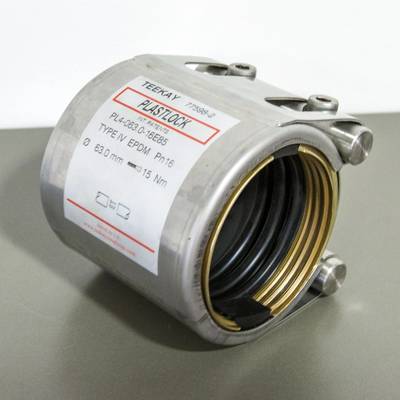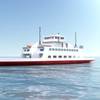Plastlock Pipe Coupling Launched at SMM
Teekay Couplings is launching its new Teekay Plastlock Pipe Coupling on September 9, the first day of the SMM marine trade fair in Hamburg, Germany. Enabling simple, rapid and permanent joining of plain-ended plastic pipes, the product will greatly increase the ability of the marine industry to specify plastic pipes in builds and therefore realise the cost, time, space, weight and simplification benefits of the material.
Key to the new product’s capability is its patented dynamic axial restraint system, which locks plastic pipes together without the need for gluing, heat fusing, flanging or pipe inserts. The system has two pipe wall gripping rings that adapt to higher levels of load as pressure in coupled pipes increases. These rings rotate on the pipe surface under higher loads, increasing the area gripping the pipe and reinforcing the seal.
This design concept follows through into the pipe anchoring mechanism, which includes three anchor rings at staggered heights. A chamber between each ring allows the pipe wall to migrate around the area where each anchor ring engages with it. These features allow for a dynamic lock on the pipe, ensuring all rings are continuously in contact with the pipe wall, resulting in a hold that permanently locks the two pipes together.
“By simply butting two plastic pipes together and connecting them with a Teekay Plastlock Pipe Coupling, engineers can create a permanent coupling in an extremely short period of time and with a structure that is often stronger than the plastic pipes it’s connecting,” said Ian Webb, director at Teekay Couplings. “This should be seen as a significant new product by the marine industry. Plastic pipes have a multitude of potential applications in marine engineering, many of which are likely to prove quietly revolutionary in what they enable designers to achieve.”
With current methods of plastic pipe joining, heat fusion or gluing, there’s a cure time, which prolongs installation and delays testing and commissioning. If cure times are not closely observed, leaks at the joints can start to appear prematurely. In addition, hot working and fumes created by gluing present risks that have to be mitigated. As a result of these considerations and costs, metal piping is still extensively used in marine engineering.
By replacing current plastic bonding methods with Plastlock, the full promise of the material can be realised: plastic piping has relatively low initial cost and can now be more quickly and easily installed, as well as maintained, further reducing costs; there’s no possibility of corrosion, so the design process is simplified, as is the resulting installation; and it’s much lighter, producing lighter vessels with resulting fuel efficiencies.
Plastlock is likely to enable major design innovations. For example, it will allow tighter and neater pipework layouts that maximise space, particularly important on passenger ships. Pre-fabricated spool pieces, produced in factory conditions and joined together on site, can now be used to simplify builds. Very low or maintenance free pipe systems will also be more cost-effective to install.
Plastlock is designed to work with a wide range of plastics used in piping, including Polyethylene, Polybutylene, Polypropylene, PVC-C, PVC-U and ABS. The range includes 15 different sized couplings, fitting pipes with outside diameters from 25mm to 315mm. Couplings to fit plastic pipes outside of the standard range can be manufactured to order. Plastlock is engineered to conform to WIS-4-24-01 and BS 851: 2103 standards. Minimum burst is four times working pressure.











